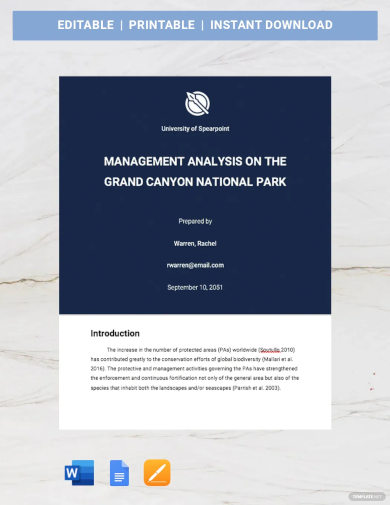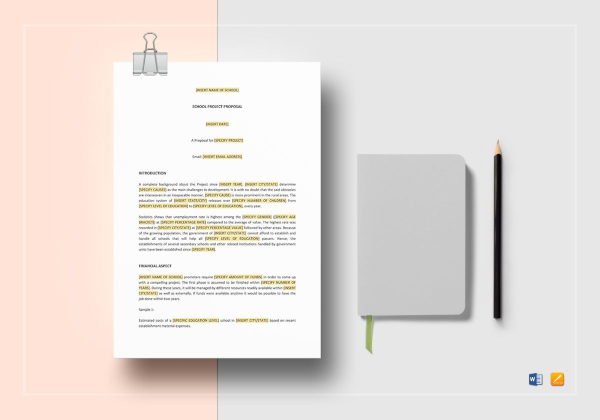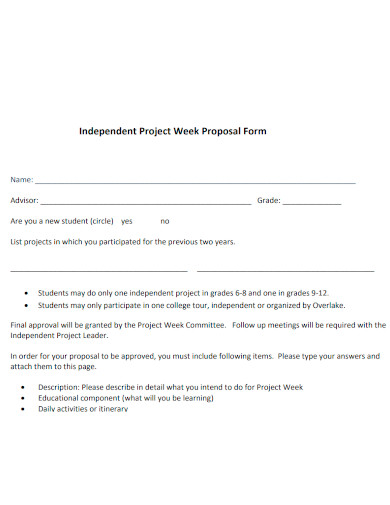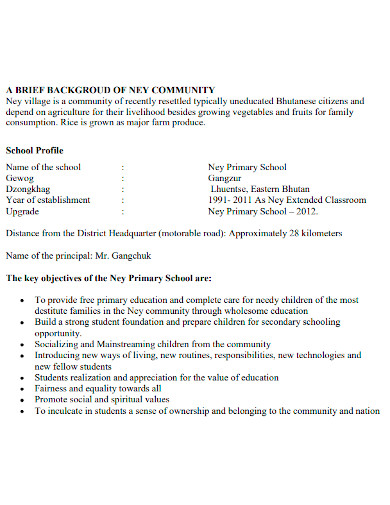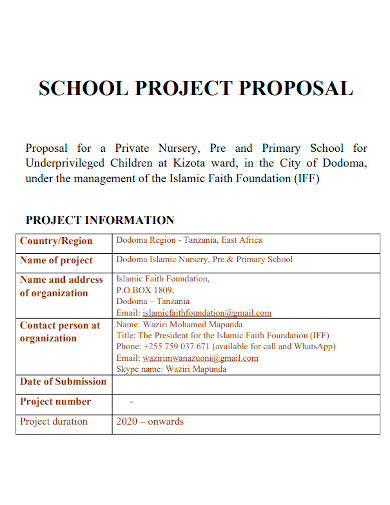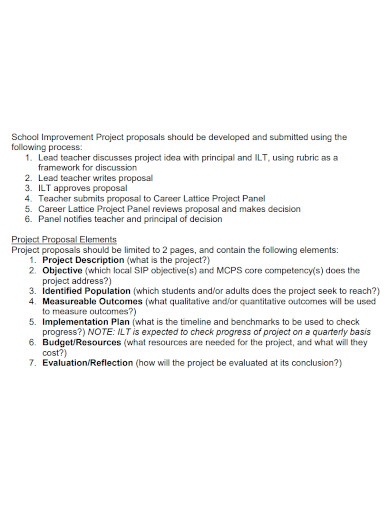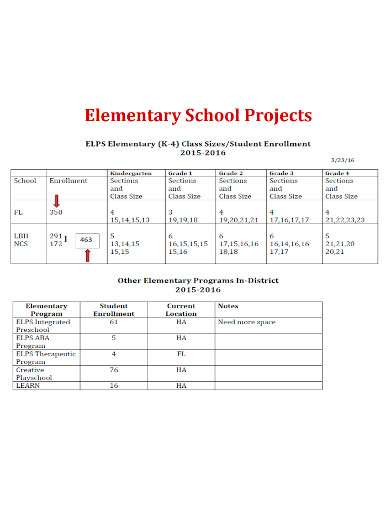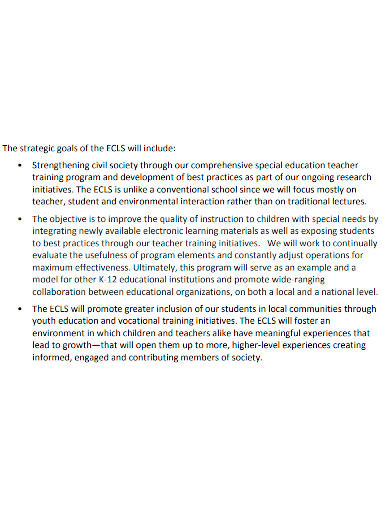Every student must have experienced creating a project proposal before a school year ends. A project proposal is simply a type of work that enables students to present their basic plans of how they are going to accomplish their research goals. Having to know how to create a project proposal is very essential because this is the kind of work that usually considered as one of the most important assignment in an academic year and demands a very thoughtful research and as well as critical thinking skills. Writing a proposal for a school project can be a very time-consuming, but if you have prepared a good outline, the work or task will be much easier for you. Most of the sample proposals usually require the same information. So once you have already mastered the style, it would be easier for you.
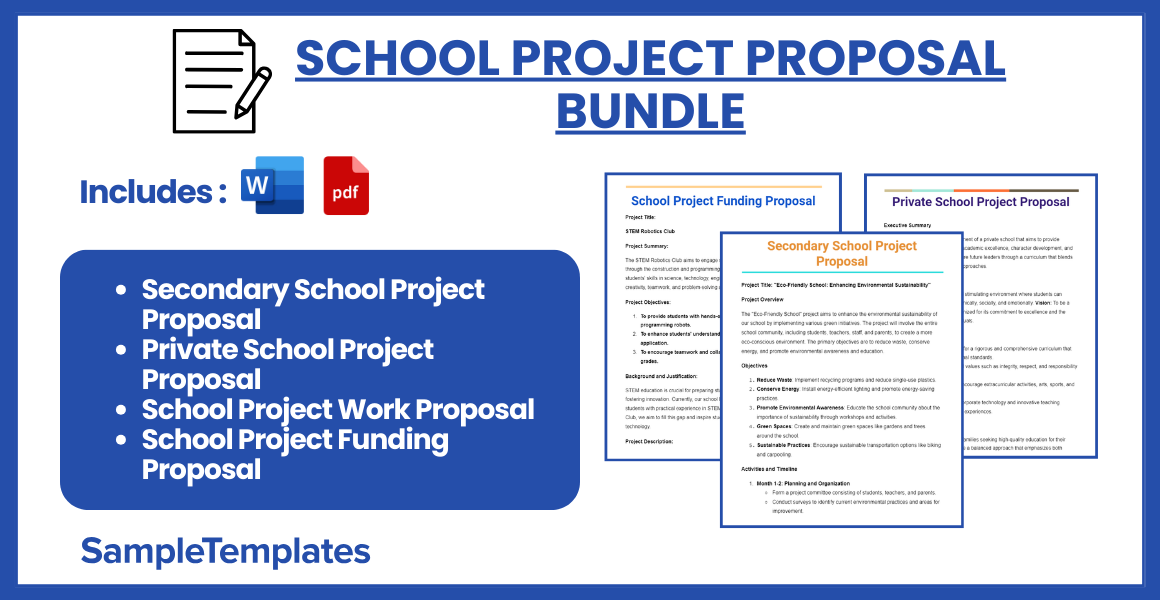
Download School Project Proposal Bundle
Secondary School Project Proposal
Project Title: “Eco-Friendly School: Enhancing Environmental Sustainability”
Project Overview
The “Eco-Friendly School” project aims to enhance the environmental sustainability of our school by implementing various green initiatives. The project will involve the entire school community, including students, teachers, staff, and parents, to create a more eco-conscious environment. The primary objectives are to reduce waste, conserve energy, and promote environmental awareness and education.
Objectives
- Reduce Waste: Implement recycling programs and reduce single-use plastics.
- Conserve Energy: Install energy-efficient lighting and promote energy-saving practices.
- Promote Environmental Awareness: Educate the school community about the importance of sustainability through workshops and activities.
- Green Spaces: Create and maintain green spaces like gardens and trees around the school.
- Sustainable Practices: Encourage sustainable transportation options like biking and carpooling.
Activities and Timeline
- Month 1-2: Planning and Organization
- Form a project committee consisting of students, teachers, and parents.
- Conduct surveys to identify current environmental practices and areas for improvement.
- Set specific, measurable goals for waste reduction, energy conservation, and other sustainability targets.
- Month 3-4: Waste Reduction Initiatives
- Launch a recycling program with clearly labeled bins for different types of waste.
- Organize workshops on reducing single-use plastics and promoting reusable alternatives.
- Implement a composting system for organic waste from the cafeteria.
- Month 5-6: Energy Conservation Measures
- Replace traditional lighting with energy-efficient LED lights.
- Install motion sensors in classrooms and hallways to reduce unnecessary lighting.
- Encourage the school community to adopt energy-saving habits, such as turning off lights and electronics when not in use.
- Month 7-8: Environmental Education and Awareness
- Organize guest lectures and workshops on environmental topics.
- Develop a curriculum module focused on sustainability and environmental science.
- Create posters, newsletters, and social media campaigns to raise awareness about the project.
- Month 9-10: Developing Green Spaces
- Identify areas within the school grounds suitable for planting trees and gardens.
- Organize tree-planting events and involve students in maintaining the green spaces.
- Collaborate with local environmental organizations for resources and support.
- Month 11-12: Promoting Sustainable Practices
- Initiate a “Bike to School” campaign and set up bike racks.
- Encourage carpooling among students and staff to reduce carbon emissions.
- Recognize and reward classes and individuals who make significant contributions to the project.
Budget
- Recycling Bins: $500
- Composting System: $300
- LED Lighting and Motion Sensors: $2000
- Educational Materials and Workshops: $700
- Green Space Development: $1500
- Promotional Materials: $200
- Miscellaneous: $300
Total Estimated Budget: $5500
Evaluation and Sustainability
- Regular Monitoring: Track progress through monthly meetings and reports.
- Feedback Mechanism: Collect feedback from the school community to improve initiatives.
- Long-term Plan: Develop a sustainability plan to ensure the project’s initiatives continue beyond the initial year.
Conclusion
The “Eco-Friendly School” project aims to make our school a model for environmental sustainability. By engaging the entire school community in these initiatives, we can reduce our environmental footprint and foster a culture of sustainability. This project will not only benefit the environment but also provide valuable learning experiences for students and create a healthier, more sustainable school environment.
Project Approval
Project Coordinator: [Your Name]
Project Advisor: [Teacher/Staff Name]
Date: [Today’s Date]
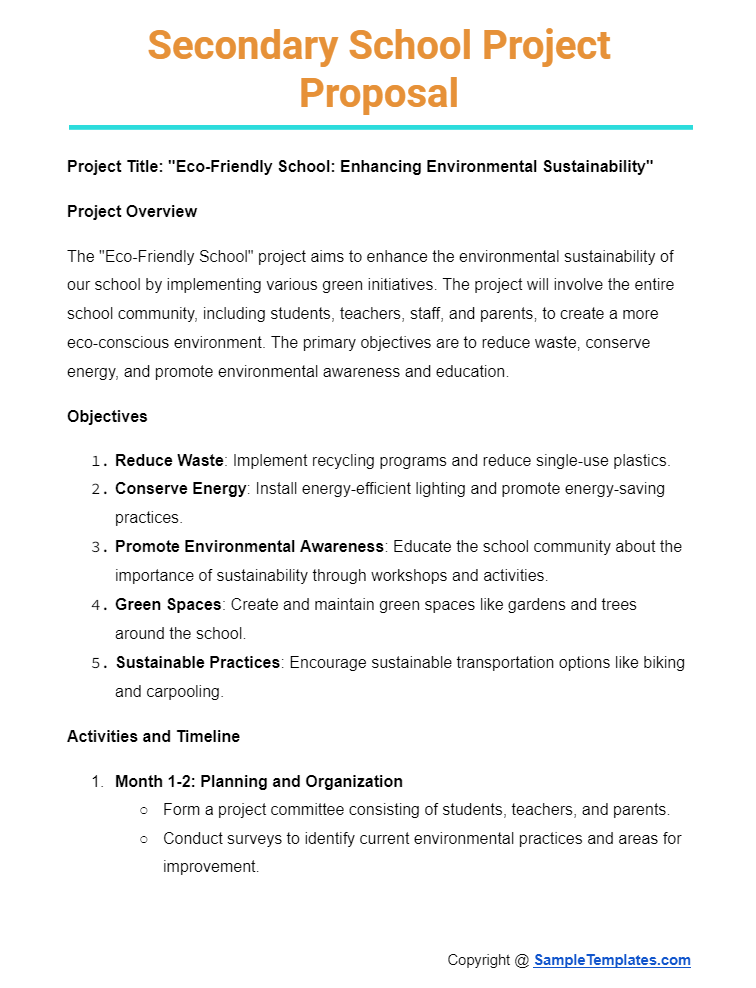
Private School Project Proposal
Executive Summary
This proposal outlines the establishment of a private school that aims to provide high-quality education, focusing on academic excellence, character development, and holistic growth. Our vision is to nurture future leaders through a curriculum that blends traditional learning with innovative approaches.
Mission and Vision
Mission: To provide a nurturing and stimulating environment where students can achieve their fullest potential academically, socially, and emotionally. Vision: To be a leading educational institution recognized for its commitment to excellence and the development of well-rounded individuals.
Objectives
- Academic Excellence: To offer a rigorous and comprehensive curriculum that meets and exceeds educational standards.
- Character Building: To instill values such as integrity, respect, and responsibility in students.
- Holistic Development: To encourage extracurricular activities, arts, sports, and community service.
- Innovative Learning: To incorporate technology and innovative teaching methods to enhance learning experiences.
Target Market
Our primary target market includes families seeking high-quality education for their children, particularly those who value a balanced approach that emphasizes both academic rigor and character development. The school will cater to students from kindergarten through 12th grade.
Location
The proposed location for the school is in a suburban area with a growing population, ensuring easy accessibility for students and staff. The location will be chosen based on factors such as safety, community support, and proximity to residential areas.
Curriculum
The curriculum will be designed to provide a strong foundation in core subjects such as Mathematics, Science, Language Arts, and Social Studies. In addition, we will offer:
- Advanced Placement (AP) courses for high school students.
- STEM (Science, Technology, Engineering, and Mathematics) programs.
- Arts and Humanities courses.
- Foreign Language instruction.
- Physical Education and health programs.
- Extracurricular Activities: Clubs, sports teams, and arts programs.
Staffing
The school will employ highly qualified and experienced educators who are passionate about teaching and committed to student success. Staff will undergo regular professional development to stay updated with the latest educational practices.
Facilities
The school campus will include:
- Classrooms: Equipped with modern technology and learning aids.
- Laboratories: For science, computer, and language studies.
- Library: Stocked with a wide range of books and digital resources.
- Sports Facilities: Including a gymnasium, sports fields, and courts.
- Arts Facilities: Including a music room, art studio, and auditorium.
- Cafeteria and Dining Area: Providing healthy meals and snacks.
- Safety Measures: Ensuring a secure environment with surveillance and emergency protocols.
Financial Plan
The financial plan includes:
- Initial Investment: Funding for land acquisition, construction, and initial operational costs.
- Revenue Streams: Tuition fees, grants, donations, and fundraising events.
- Budgeting: Detailed budgeting for salaries, maintenance, utilities, and educational materials.
- Sustainability Plan: Strategies for long-term financial stability and growth.
Marketing Strategy
Our marketing strategy will focus on:
- Community Engagement: Building relationships with local families and community leaders.
- Online Presence: Developing a user-friendly website and active social media channels.
- Open Houses: Hosting events for prospective students and parents to visit the campus.
- Advertising: Utilizing local media, brochures, and word-of-mouth referrals.
Evaluation and Assessment
To ensure continuous improvement, the school will implement:
- Regular Assessments: Standardized testing and formative assessments.
- Feedback Mechanisms: Surveys for students, parents, and staff.
- Performance Reviews: Regular evaluation of staff performance and professional development needs.
- Accreditation: Seeking accreditation from reputable educational organizations.
Conclusion
This private school project aims to provide a high-quality education that prepares students for future success. With a dedicated team, a comprehensive curriculum, and a commitment to excellence, we are confident in our ability to create a nurturing and stimulating learning environment. We seek support and collaboration from stakeholders to make this vision a reality.
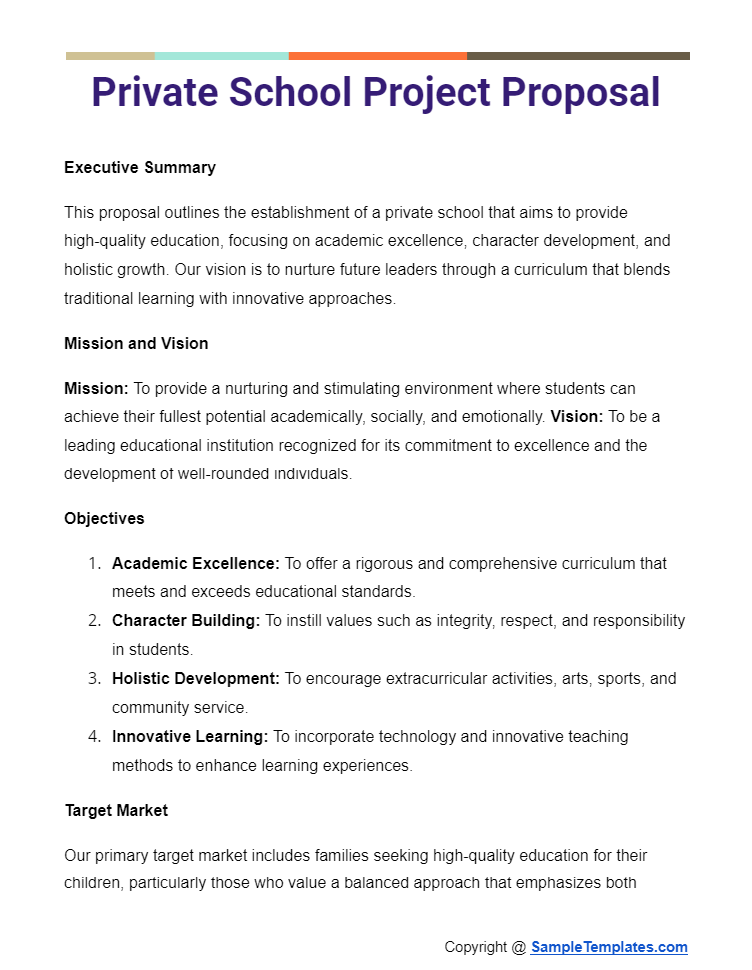
School Project Work Proposal
Project Title:
Enhancing School Recycling Program
Project Team:
- Team Leader: [Your Name]
- Team Members: [List of Team Members]
Project Overview:
The project aims to enhance the existing recycling program at our school by introducing new initiatives and improving current practices. The goal is to increase recycling rates, reduce waste, and educate students and staff about the importance of recycling and sustainability.
Objectives:
- Assess the current state of the school’s recycling program.
- Identify areas for improvement and potential new initiatives.
- Implement changes to increase the efficiency and effectiveness of recycling practices.
- Educate the school community about the benefits of recycling and how to participate in the program.
- Measure the impact of the improved recycling program over time.
Scope of Work:
- Research and Assessment:
- Conduct surveys to gather information on current recycling practices and participation levels.
- Analyze waste management data to identify the types and quantities of recyclable materials.
- Development of Initiatives:
- Propose new recycling initiatives, such as composting organic waste, electronic waste recycling, and setting up recycling stations for different materials.
- Collaborate with local recycling facilities and environmental organizations for support and resources.
- Implementation:
- Set up additional recycling bins and stations around the school.
- Create informative posters and digital content to promote the program.
- Organize workshops and presentations to educate students and staff.
- Monitoring and Evaluation:
- Track recycling rates and waste reduction over a specified period.
- Conduct follow-up surveys to assess changes in awareness and behavior.
- Analyze data to determine the effectiveness of the initiatives and identify areas for further improvement.
Timeline:
- Week 1-2: Research and assessment phase.
- Week 3-4: Development of initiatives.
- Week 5-6: Implementation of changes.
- Week 7-8: Monitoring and evaluation.
Budget:
- Recycling Bins and Stations: $200
- Promotional Materials: $100
- Workshops and Presentations: $50
- Miscellaneous Expenses: $50
- Total Budget: $400
Expected Outcomes:
- Increased recycling rates and reduced waste in the school.
- Greater awareness and participation in the recycling program among students and staff.
- A sustainable model for recycling that can be maintained and built upon in the future.
Evaluation:
- Success will be measured by the increase in the quantity of materials recycled, reduction in overall waste, and positive feedback from the school community.
- Surveys and waste audits will be conducted to gather quantitative and qualitative data on the program’s impact.
Conclusion:
This project aims to make a significant contribution to our school’s environmental sustainability efforts. By enhancing the recycling program, we can foster a culture of environmental responsibility and set an example for other schools to follow.
Please review this proposal and provide feedback or approval so we can proceed with the project. Thank you for your support!
Sincerely,
[Your Name]
[Your Position]
[Contact Information]
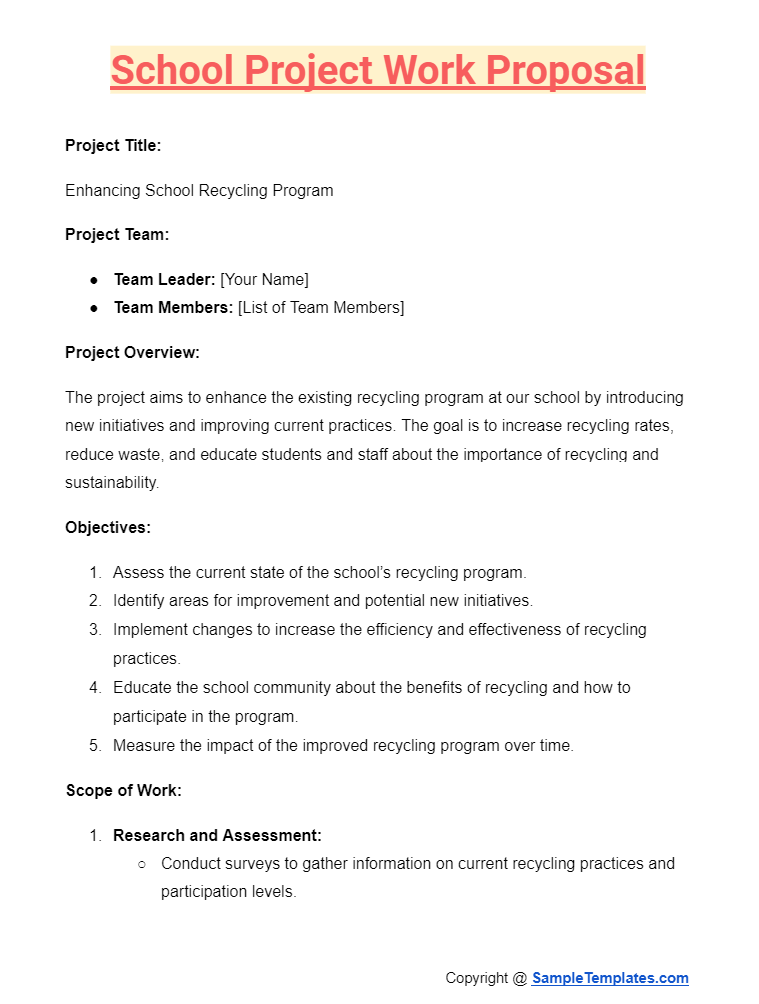
School Project Funding Proposal
Project Title:
STEM Robotics Club
Project Summary:
The STEM Robotics Club aims to engage students in hands-on learning experiences through the construction and programming of robots. This project seeks to enhance students’ skills in science, technology, engineering, and mathematics (STEM), fostering creativity, teamwork, and problem-solving abilities.
Project Objectives:
- To provide students with hands-on experience in building and programming robots.
- To enhance students’ understanding of STEM concepts through practical application.
- To encourage teamwork and collaboration among students from different grades.
Background and Justification:
STEM education is crucial for preparing students for the future job market and for fostering innovation. Currently, our school lacks a dedicated program that provides students with practical experience in STEM fields. By establishing the STEM Robotics Club, we aim to fill this gap and inspire students to pursue careers in science and technology.
Project Description:
The STEM Robotics Club will meet twice a week after school for two hours. Students will work in teams to design, build, and program robots using kits and software provided by the club. The project will culminate in a school-wide robotics competition.
- Activities and Tasks:
- Activity 1: Initial training sessions on basic robotics and programming concepts.
- Activity 2: Team-based robot design and construction.
- Activity 3: Programming and testing the robots.
- Activity 4: Final robotics competition.
- Timeline:
- Phase 1 (Month 1): Recruitment and initial training.
- Phase 2 (Months 2-3): Robot design and construction.
- Phase 3 (Months 4-5): Programming and testing.
- Phase 4 (Month 6): Robotics competition and project evaluation.
Budget:
The total budget for the STEM Robotics Club is $5,000, which will cover materials, equipment, and other necessary expenses.
- Materials and Supplies:
- Robotics Kits: $2,000
- Programming Software Licenses: $500
- Building Supplies: $300
- Equipment:
- Laptops for Programming: $1,500
- Storage Cabinets: $300
- Other Expenses:
- Competition Prizes: $200
- Miscellaneous Supplies: $200
- Total Budget:
- $5,000
Evaluation:
The project will be evaluated based on student participation, progress in building and programming robots, and performance in the final competition. Surveys and feedback forms will be used to assess the impact on students’ interest and skills in STEM.
Sustainability:
To ensure sustainability, we plan to seek additional funding from local businesses and grants. The equipment and materials purchased will be reusable for future sessions of the club, and we aim to establish a self-sustaining model through fundraising activities and community support.
Conclusion:
The STEM Robotics Club will provide invaluable learning experiences for our students, equipping them with essential skills for the future. We respectfully request funding to support this initiative and are grateful for your consideration.
Contact Information:
- Name: Jane Smith
- Title: STEM Coordinator
- Email: [email protected]
- Phone Number: (555) 123-4567
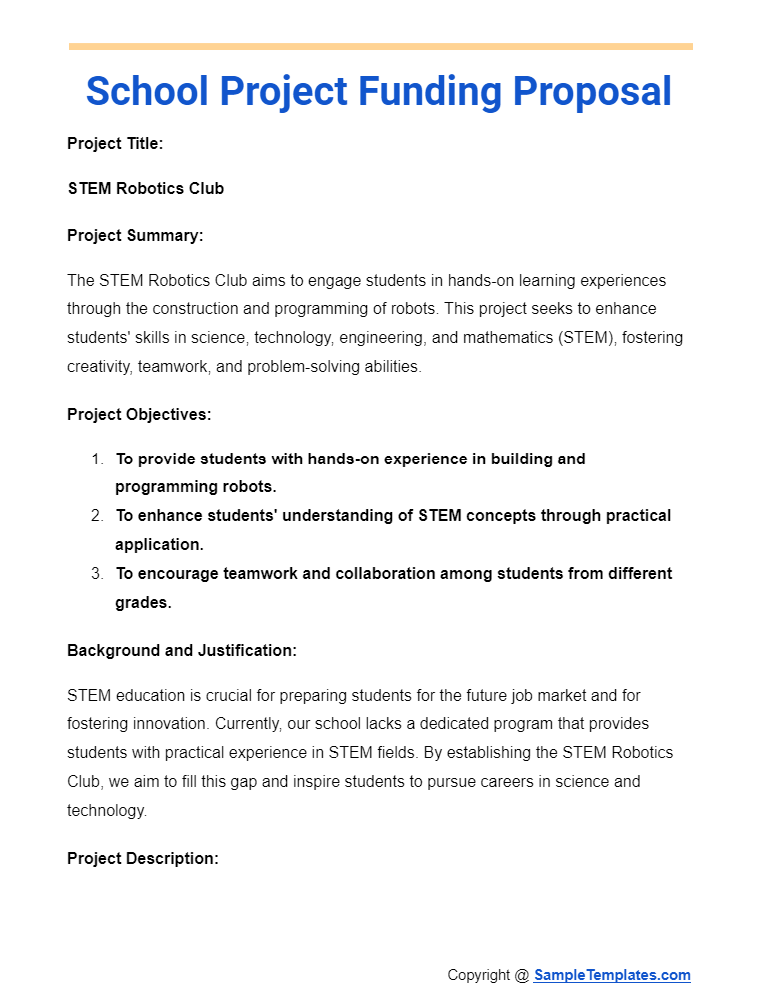
Browse More Templates On School Project Proposal
1. School Project Proposal Samples
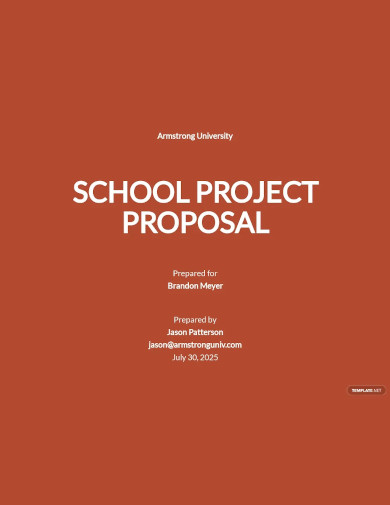
2. School Improvement Project Proposal Template
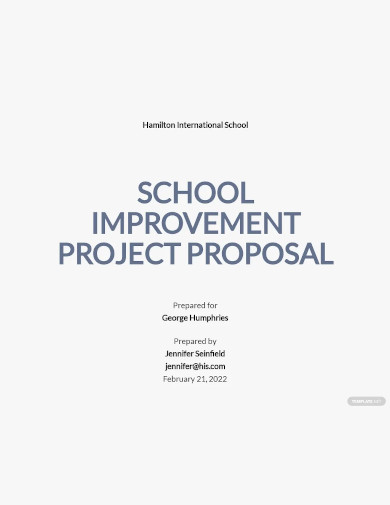
3. School Project Proposal Letter Template
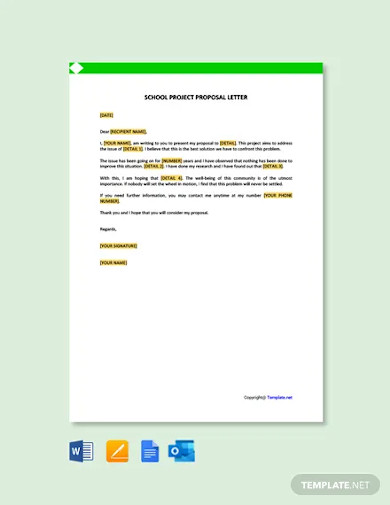
How to Write a Project Proposal for a School?
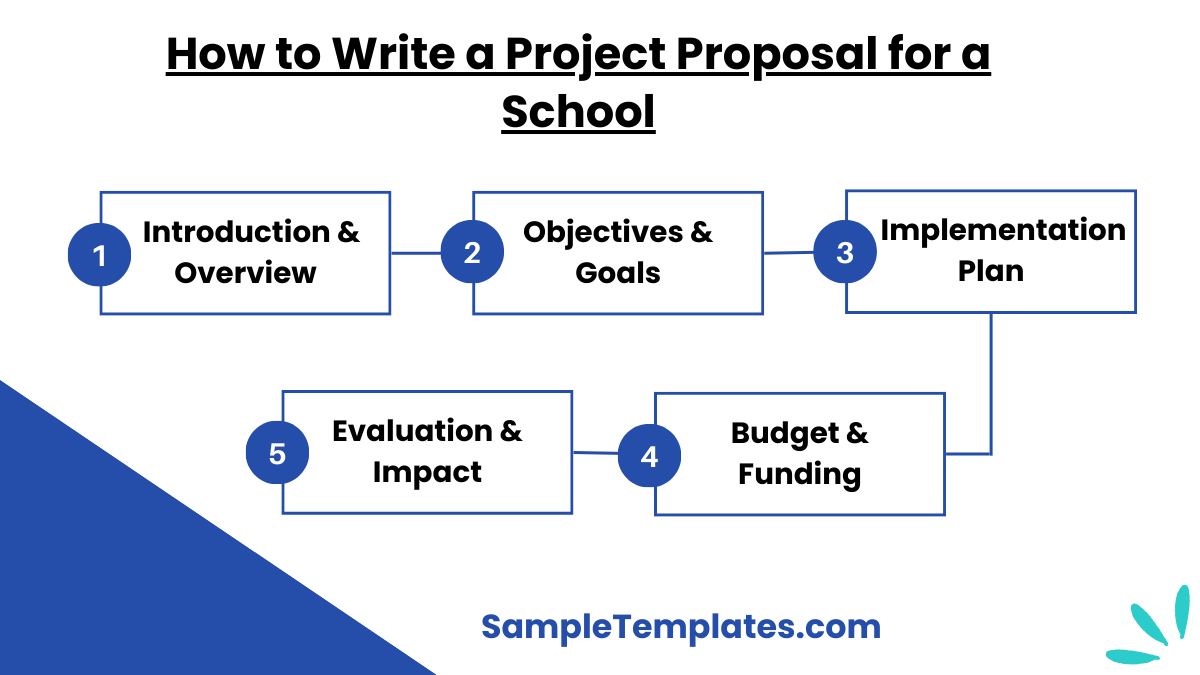
- Introduction and Overview
- Start with a brief introduction of the project, including the title, purpose, and a summary of what the project entails.
- Mention the target audience (students, teachers, specific grade levels) and the scope of the project.
- Objectives and Goals
- Clearly state the objectives of the project. What do you aim to achieve?
- Outline specific, measurable goals. For example, “Improve students’ understanding of environmental science by 20% through hands-on activities.”
- Implementation Plan
- Provide a detailed plan on how the project will be implemented. Include timelines, key milestones, and tasks. You can also see more on School Proposal.
- Specify the roles and responsibilities of each team member involved in the project.
- Mention any resources or materials needed for the project.
- Budget and Funding
- Include a detailed budget outlining the costs associated with the project. This should cover materials, resources, and any other expenses.
- If applicable, mention potential sources of funding or any fundraising activities planned to support the project.
- Evaluation and Impact
- Explain how the success of the project will be measured. What are the criteria for evaluating the outcomes?
- Describe the expected impact of the project on the school community. How will it benefit students, teachers, or the overall learning environment?
- Include any plans for sustaining the project or its benefits after the initial implementation. You can also see more on Student Project Proposal.
4. School Student Project Proposal Template
5. Sample School Project Proposal Template
6. School Independent Project Proposal Template
7. Sample Primary School Project Proposal Template
Benefits of School Project Proposal
- Clarifies Objectives and Goals
- Helps define clear, specific objectives and goals for the project, ensuring everyone involved understands the purpose and desired outcomes. You can also see more on Course Project Proposal.
- Organizes Planning and Implementation
- Provides a structured plan for how the project will be executed, including timelines, resources, and responsibilities, which helps in smooth implementation.
- Facilitates Communication
- Acts as a communication tool that can be shared with stakeholders, including school administration, teachers, parents, and potential funders, to garner support and feedback.
- Secures Funding and Resources
- A well-written proposal can attract funding and resources from various sources, including school budgets, grants, and community sponsors.
- Enhances Accountability
- Establishes clear roles and responsibilities, which ensures accountability among team members and stakeholders throughout the project. You can also see more on School Safety Proposal.
- Measures Success
- Outlines methods for evaluating the project’s success, making it easier to assess whether the objectives have been met and to identify areas for improvement.
- Encourages Collaboration
- Promotes collaboration among students, teachers, and other stakeholders, fostering a sense of teamwork and shared purpose.
- Demonstrates Professionalism
- Shows a high level of professionalism and preparedness, which can enhance the credibility of the project and those involved.
- Supports Decision-Making
- Provides detailed information that can aid school administrators and decision-makers in approving and supporting the project. You can also see more on Activity Proposal.
- Promotes Innovation and Improvement
- Encourages innovative thinking and continuous improvement in educational practices, ultimately benefiting the learning environment and student outcomes.
8. Printable School Project Proposal Template
9. Standard School Project Proposal Template
10. School Project Proposal Format
11. Elementary School Project Proposal Template
Tips For Writing a Project Proposal
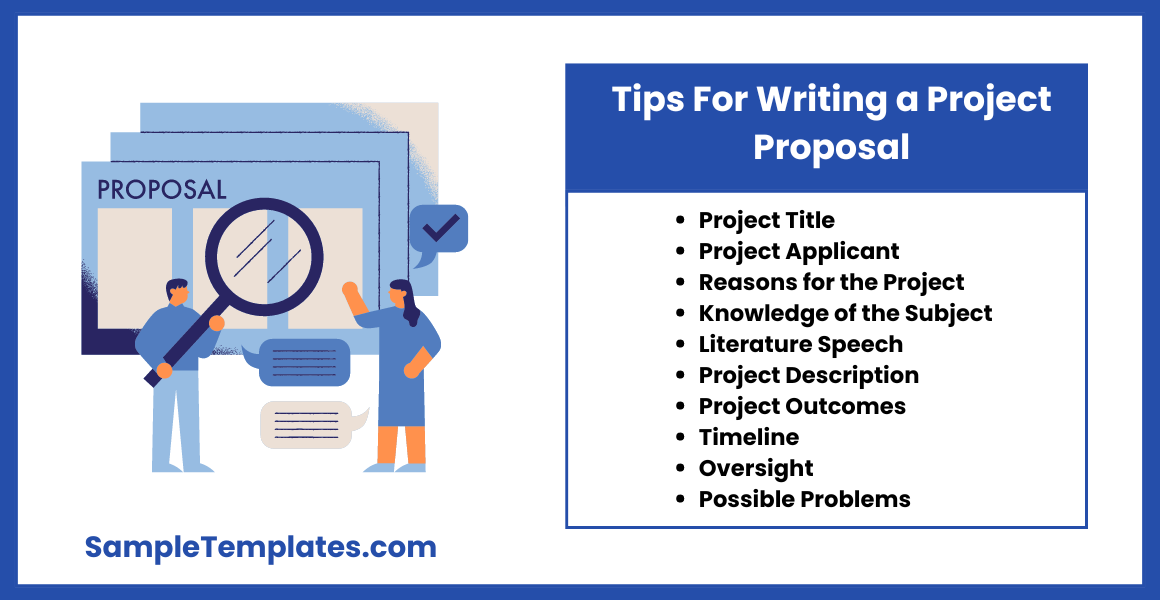
Most of the project proposals have the same elements. It can be the following:
- Project Title – it should be short and descriptive so the reader may have an idea about what you are trying to create or develop. Do not use words that are considered rude or inappropriate.
- Project Applicant – include your name, grade, class, and your contact information intended for anyone who reads your project.
- Reasons for the Project – this section will let you explain what you want to do with your project. You just have to make sure that your proposal is clear especially with why you have to accomplish this project scope.
- Knowledge of the Subject – you should be able to provide a description on what you already know about the subject or proposal. It may also include information regarding what you want to learn about the subject matter.
- Literature Speech – you should be able to know how your research would fit into the society. Try to assess if there is still someone else writing about the same thing, if the topic is interesting to others, how many sample books are already written in relation to the topic, and if there are websites containing the same information.
- Project Description – you have to sell your idea in which it has to be clear and specific in any ways. Project descriptions answers the what, where, when, why, who, and how of the work. You should also write using the first person point of view. Do not make a lengthy and complicated sentences. Describe what you really want to do and what you are trying to accomplish.
- Project Outcomes – it should be more specific as this section is trying to tell the reader what you expect to create and produce. If you make something that people can use, give them an instruction on how they are going to use it.
- Timeline – indicate what type of activity you are going to do on a specific time or date.
- Oversight – provide an explanation as to who is mentoring you and why you think that person is best for the job.
- Possible problems – you may discover a lot if you are working on a new project, so you have to spot what seems to be the problem at an early stage.
12. Formal School Project Proposal Template
13. Editable School Project Proposal Template
FAQs
What is the purpose of an education proposal?
The main purpose of an education proposal is to secure a grant money to be able to get an approval for a particular education project proposal.
How do you write a proposal for an education project?
Start with an abstract, write the needs assessment, include program description, describe how a project will be implemented, list the key personnel, budget and justification, and methods and measurement tools used.
How to prepare a proposal?
Identify objectives, outline a detailed plan, create a realistic budget, define roles, and highlight benefits. Review and revise for clarity and coherence.
How do you write a project proposal for beginners?
Define the project’s purpose, set clear goals, outline steps, allocate budget, and assign responsibilities. Ensure simplicity and clarity. Review thoroughly. You can also see more on Student Council Proposal.
If you want to see more samples and format, check out some of the school project proposal samples and templates provided in the article analysis for your sample reference.
Related Posts
FREE 10+ Product Supply Proposal Samples in MS Word | Google Docs | Apple Pages | PDF
FREE 10+ Health Project Proposal Samples [ Public, Mental, Healthcare ]
FREE 11+ Engineering Project Proposal Samples in PDF | MS Word
FREE 4+ Racing Sponsorship Proposal Samples [ Team, Car, Driver ]
FREE 10+ Nursing Project Proposal Samples [ Community, Health, Clinical ]
FREE 11+ Student Council Proposal Samples in PDF | DOC
FREE 10+ Facilities Management Proposal Samples in MS Word | Google Docs | Apple Pages | PDF
FREE 8+ Joint Venture Proposal Samples [ Commercial, Real Estate, Construction ]
FREE 10+ Scholarship Proposal Samples [ Project, Grant, Sponsorship ]
FREE 10+ Computer Purchase Proposal Samples in MS Word | Google Docs | Apple Pages | PDF
FREE 10+ Network Project Proposal Samples [ Design, Security, Bank ]
FREE 14+ Accounting Proposal Samples in PDF | MS Word
FREE 10+ Church Event Proposal Samples in MS Word | Google Docs | Apple Pages | PDF
FREE 10+ History Proposal Samples [ Dissertation, Thesis, Paper ]
FREE 34+ Sponsorship Proposal Samples in PDF | MS Word | Pages | Google Docs

